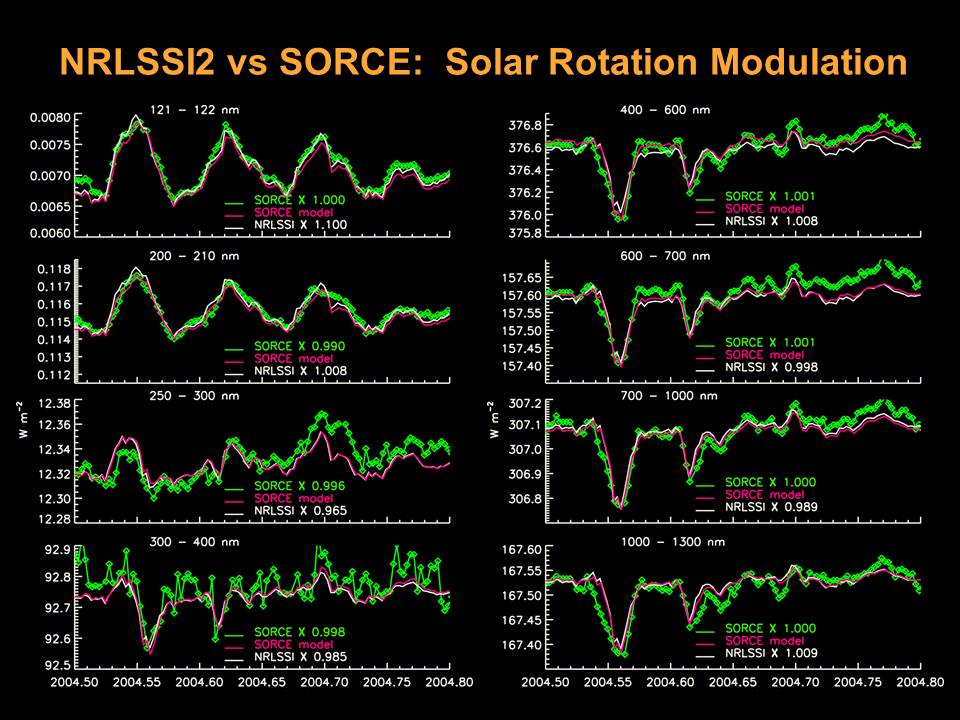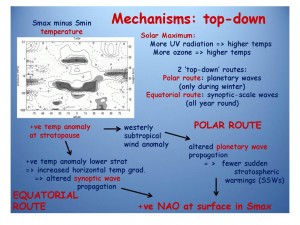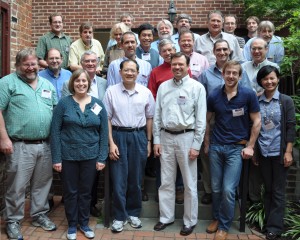2012 SORCE Science Team Meeting Summary
Annapolis, Maryland, Sept. 18-19, 2012
By:
Jerald Harder, LASP, University of Colorado, Jerry.Harder@lasp.colorado.edu
Martin Snow, LASP, University of Colorado, Marty.Snow@lasp.colorado.edu
Tom Woods, LASP, University of Colorado, Tom.Woods@lasp.colorado.edu
The SOlar Radiation and Climate Experiment (SORCE) team continued its series of science meetings in Annapolis, MD, September, 18-19, 2012. The title of this year’s meeting was Solar Spectral Irradiance Variability: Origins in the Solar Atmosphere and Impacts on Earth’s Atmosphere. The two-day meeting had two sessions each day, one on observations and one on models. A poster session held late on the first afternoon crossed-over all topics of the meeting.
This year’s SORCE Science Team Meeting revolved around key scientific questions that span issues related to our ability to understand the origins of spectral irradiance in the solar atmosphere, and how these variations impact Earth’s atmosphere and climate. Many interesting and perhaps even conflicting perspectives were presented at this meeting, demonstrating that our knowledge of the role of solar variability in understanding climate change remains ‘low’ as stated in the most recent Intergovernmental Panel on Climate Change (IPCC) Report. However, the SORCE Meetings provide an effective forum for addressing these outstanding and important climate sensitive issues and provide inspiration for future studies.
2012 SORCE Meeting Focus Questions:
- Development of three-dimensional (3-D)models of the solar atmosphere are rapidly progressing; how will these models further our understanding of the radiative properties of the solar atmosphere relative to static 1-D models of the solar radiation?
- Do small scale processes on the Sun scale to give irradiance variability, and do they give a reasonable explanation of changes that can occur on decadal or centennial scales that relate to climate change?
- Does incorporating solar spectral irradiance (SSI) data into general circulation models (GCMs) improve the prediction skills of these models, and do different models produce similar results with the same solar input?
- For both solar models and GCMs, how well do model predictions agree with observations over decadal time scales?
The first session, Modeling of the Solar Atmosphere with Emphasis on Spectral Irradiance, featured talks on state-of-the-art models of the Sun. The first keynote talk, by Han Uitenbroek [National Solar Observatory], showed that one-dimensional (1-D) model radiance is expected to be lower than the 3-D model due to the way temperature is averaged. Regner Trampedach [University of Colorado (CU)] presented modeling results showing that flux tubes in active regions heat in a lateral direction and show brightness variations with viewing angle. This provides a better understanding of the cause of center-to-limb variability of active regions. Juan Fontenla [NorthWest Research Associates; Laboratory for Atmospheric and Space Physics / CU (LASP)] discussed the continued importance of 1-D modeling in light of the fact that the physical mechanisms of chromospheric and coronal heating are not yet fully understood. Even with recent advances in computing power and algorithms, it is currently not practical to use full 3-D solar models for irradiance studies.

Figure 1. Judith Lean [Naval Research Laboratory (NRL) presented the NRL SSI (Solar Spectral Irradiance) model and compared it to observations from SORCE. The short-term solar variations, related mostly to the 27-day solar rotation, are in very good agreement.
The North Atlantic Oscillation (NAO) may have little impact on global temperatures, but it plays an important role in regional climate, making it a topic of great interest due to the need for long-term weather forecasting, particularly in Northern Europe. Session 2, Modeling of the Solar Influence on Earth Climate, began with keynote speaker Sarah Ineson [British Meteorology Office, UK], who talked about the NAO and the potential role of solar variability in this phenomenon. Ineson and her colleagues have studied the effects of enhanced solar ultraviolet (UV) variability forcing a positive NAO, which then explains the extra heating in Europe during solar maximum conditions. Figure 2 shows how the Earth responds to changes in UV SSI. Although uncertainties in NAO measurements are about as large as the forcing from SSI, the signal appears be large enough to play a useful role in seasonal to decadal climate predictions for Europe.
Concluding the session, William Ball [Imperial College, UK] and William Swartz [Johns Hopkins University] showed the results from model-based sensitivity studies to provide insights into predicting ozone changes in the stratosphere from solar variability. Charles Jackman [NASA Goddard Space Flight Center (GSFC)] and Cora Randall [LASP] discussed in detail the mechanisms of how energetic protons and electrons impact polar NOy chemistry that have an influence over time spans of several months.

Figure 2. Sarah Ineson presented this figure, (courtesy of Lesley Gray, University of Oxford), which explains a top-down mechanism for how solar cycle variability in stratospheric ozone and heating can induce planetary wave propagation through two routes to produce a positive (labeled +ve in the figure) NAO response.
The next session of the meeting concentrated on the measurements of SSI. The main focus was on comparisons between observations from SORCE and other solar irradiance instruments, both orbiting and ground-based. Tom Woods [LASP; SORCE Principal Investigator] summarized the comparisons nicely with an analysis of all the existing UV datasets over the past three solar cycle minima. Except for the 250-400 nm spectral region, the majority of the published datasets are actually in fairly good agreement. His ultimate conclusion was that the long-term record supports the higher UV variability measured by SORCE. However, his method has an uncertainty of about 20% in variability, which is close to the measurement uncertainty in many cases.

Figure 3. This plot from Tom Woods shows a comparison of several solar irradiance models with his solar cycle 21-24 composite middle UV (MUV) spectrum constructed from several instruments (Solar Mesosphere Explorer (SME), Upper Atmosphere Research Satellite (UARS) SOLSTICE, UARS Solar Ultraviolet Spectral Irradiance Monitor (SUSIM) , SORCE SIM, and SORCE SOLSTICE). The composite is generally higher than the models in the 290-350 nm range. This composite construction indicates lower UV variability than presented in Harder et al. (2009).
There were also a wide variety of talks on observations of SSI in the visible and near infrared (NIR) spectral bands (Session 3). Of particular interest, the SORCE SIM results indicate that some wavelengths in the visible and NIR are out of phase with the solar cycle (that is, more irradiance at solar minimum). One of the more unusual datasets discussed was from the Solar and Heliospheric Observatory satellite’s Large Angle and Spectrometric Coronagraph (SOHO LASCO). Russell Howard’s [NRL] presentation on scattered light from the solar corona was a unique measurement of solar variability at visible wavelengths and gave results consistent with TSI variations measured by SORCE’s TIM. His scattered light measurements indicate that SSI variations are in-phase with the solar cycle in the visible spectral band. Dora Preminger [San Fernando Observatory (SFO), University of California-Northridge] presented ground-based solar image analysis which shows out-of-phase solar cycle variations in the visible, but with a smaller magnitude than observed by SORCE SIM. The talk given by Mark Rast [LASP] could provide insight into resolving the contradictory results for the visible spectral band. He discussed ‘dark plage’ observation from Mauna Loa Observatory, suggesting that some plage can appear dark relative to the quiet Sun, and the fraction of faculae showing such negative continuum contrast varies with the solar cycle, decreasing into solar minimum and increasing again coming out of it. Exactly how this darkening would manifest itself in the SFO and SOHO records could be the answer to how some wavelengths in the visible could be out-of-phase with the solar cycle in one dataset and not in the other.
The session closed with a broader perspective of the solar cycle. Ken Tapping [National Research Council, Canada] updated his study of the 65-year record of the F10.7 coronal measurement relative to the sunspot record showing that F10.7 and sunspot number continue to diverge in interesting ways, first starting in solar cycle 23 (1996-2008) and perhaps continuing into cycle 24. This divergence in variability relationships might be an indicator of secular solar variations. One of his interesting conclusions is that solar cycle 24 may have already peaked in November 2011, in contrast to the NASA-NOAA (National Oceanic and Atmospheric Administration) Solar Cycle Panel predicting that cycle 24 might have its maximum in mid 2013.
The final session of the meeting tackled observations and models of Earth’s atmosphere as related to solar cycle variations. One important topic was the comparisons of 2-D and 3-D atmospheric models. There appears to be good consistency in the results between different models suggesting that the chemistry and dynamics in these models are well-represented in both. Several model comparisons using either the NRL SSI model or SORCE SIM measurements indicate that the UV variability observed by SIM should produce a larger stratosphere-mesosphere change of O3 and OH than with results using NRL SSI. Different atmospheric measurements can provide diverse, and seemingly conflicting conclusions on which solar variability inputs to the models produce results that best agree with the atmospheric observations. How the ozone data are analyzed can be one critical component in such comparisons. For example, Aimee Merkel [LASP] showed observations where day-time and night-time data can be separated to show out-of-phase solar cycle changes in the lower mesosphere. Therefore, ozone datasets derived entirely from occultation measurements, which are always from dawn or dusk conditions, could mask the true solar forcing effects on a global scale.
Many of the 2012 SORCE Meeting presentations are available online at: http://lasp.colorado.edu/sorce/news/2012ScienceMeeting/.
The final topic of discussion was on the theme of the next SORCE Science Team Meeting. It was generally agreed that rather than a 10-year anniversary meeting, we should have an 11-year celebration in honor of SORCE’s observations over the 11-year solar cycle. So look for the next SORCE Meeting to be in early 2014 with focus topics concerning the key results during the SORCE mission.
References:
Harder, J., et al., Geophysical Research Letters, 36, L07801, 2009.
BONUS…
1-Day Workshop Summary: Understanding Trends in Solar Spectral Irradiance
By Martin Snow, LASP, University of Colorado, Marty.Snow@lasp.colorado.edu
Prior to the SOlar Radiation and Climate Experiment (SORCE) Science Team Meeting, experts in measuring solar spectral irradiance (SSI) from around the world met on September 17, 2012 in Annapolis, MD to discuss the recent SSI observations. The primary topic of interest is that the SORCE measurements show larger solar variability in the descending phase of solar cycle 23 (i.e. from mid-2003 to the end of 2008) than most other previous instruments in solar cycle 22. This workshop was the sequel to a workshop held at the National Institute of Standards and Technology (NIST) in February 2012 which was described in Harder et al., SORCE SSI Workshop Summary, The Earth Observer, August 2012, p 17. The ultimate goal of these SSI workshops is to understand the uncertainties in the comparisons to previous and overlapping datasets and to validate the SORCE measurements.
The primary source of uncertainty in any long-term SSI dataset is uncertainty in the correction for instrument degradation. The morning session featured presentations on improvements to the current SORCE degradation functions for the Solar-Stellar Irradiance Comparison Experiment (SOLSTICE) and the Solar Irradiance Monitor (SIM) by Martin Snow, Jerald Harder, and Stéphane Beland [Laboratory for Atmospheric and Space Physics, University of Colorado (LASP)]. There was also a discussion of an alternative algorithm for determining the SIM degradation function presented by Odele Coddington [LASP], which folds in an estimate of the radiation dose seen by the instrument as a function of time. This dose model approach was inspired from the discussions held at the February workshop.
The morning session was rounded out by a discussion of the general approach that should be used in operating an instrument with multiple channels. Erik Richard [LASP] showed test results from the Total and Spectral Irradiance Sensors (TSIS) which is currently under development at LASP. Linton Floyd [Interferometrics, Inc.] shared some valuable insight based on degradation measurements from the Solar Ultraviolet Spectral Irradiance Monitor (SUSIM) on the Upper Atmosphere Research Satellite (UARS).
The afternoon session was devoted to comparison of measurements from SORCE to other instruments. Alexander Shapiro [Physikalisch-Metorologisches Observatorium Davos (PMOD), Switzerland] showed comparisons to broadband photometers on Solar and Heliospheric Observatory (SOHO), PICARD1, and PROject for Onboard Autonomy 2 (PROBA2) satellites. Gerard Thuillier [Laboratoire Atmosphères, Milieux, Observations Spatiales (LATMOS-CNRS)] showed ratios to the SOLar SPECtrum (SOLSPEC) instrument on the International Space Station (ISS), and Linton Floyd [Interferometrics, Inc.] compared SOLSTICE and SIM to the UARS SUSIM data taken during 2003 and 2005. There was an analytical statistical analysis of the measurements and models presented by Jae Lee [NASA Goddard Space Flight Center (GSFC)], and finally a re-analysis of multi-solar cycle trends presented by Tom Woods [LASP]. One of the workshop conclusions is that differences in solar cycle variability between the different instruments appears to be within the uncertainty of instrument degradation trends for many of the wavelengths, especially so for longer than 250 nm.

SSI Trends Workshop participants. Front row: Martin Snow, Odele Coddington, Guoyong Wen, Don McMullin, William Ball, Jae Lee; 2nd row: Tom Woods, Gerard Thuillier, Matt DeLand, William McClintock, Jerry Harder, Stéphane Beland, Linton Floyd; 3rd row: Doug Lindholm, Peter Pilewskie, Judith Lean, Erik Richard, Dong Wu, Bob Cahalan, Tom Sparn, Gary Rottman, Alexander Shapiro, Dave Harber, and Jeff Morrill.
1 PICARD is not an acronym, but rather named after the French astronomer Jean Picard (1620-1682) who achieved the first accurate measurements of the solar diameter.
«Return to the Meetings/News page


